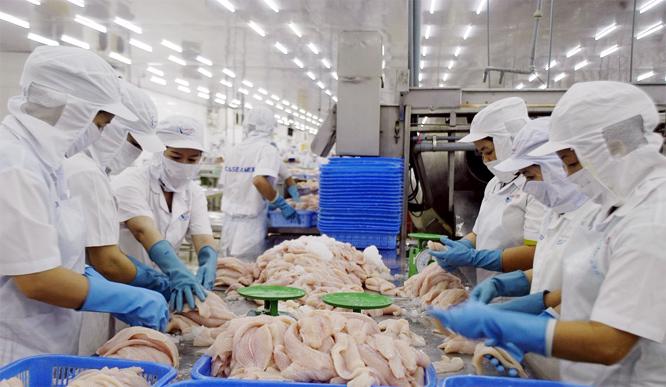Vietnam exports one step closer to US$368-billion target
The country has posted a trade surplus of nearly $11 billion.
Vietnam’s exports in the January-November period rose by 13.4% year on year to US$342.2 billion, making it one step closer to the Government’s target of $368 billion for this year.
| Catfish has been a highlight of Vietnam's exports. Photo: Giang Lam |
Data from the Ministry of Industry and Trade (MoIT) revealed Vietnam’s total trade turnover in the 11 months stood at $673.8 billion, representing an increase of 11.8% year on year and surpassing last year’s figure at $668.5 billion with one more month to go.
Upon breaking down, exports were estimated at $342.2 billion, up 13.4% year on year, and imports of $331.6 billion, up 10.1%, resulting in a trade surplus of $10.6 billion.
The US remained Vietnam’s largest export market with a turnover of $101.5 billion, and China topped the import markets with $109.9 billion.
A highlight in Vietnam’s trade performance during the period was seafood exports, which for the first time hit the $ 10 billion revenue mark, and is on track to reach $11 billion by year-end. Shrimp exports surged 30% to $4.3 billion, and catfish by a whopping 80% to over $2 billion.
General Secretary of the Vietnam Association of Seafood Exporters and Producers (VASEP) Truong Dinh Hoe highlighted the remarkable milestone for the local fishery industry by realizing the $10 billion goal three years in advance of the target set by the prime minister for 2025.
Do Xuan Lap, chairman of the Vietnam Timber and Forest Production Association (VIFOREST), also expressed his optimism for the wood sector to achieve the export target of $16.5 billion this year, with the figure currently at $14.6 billion as of November.
“Exports of wood and wooden products are normally higher during the late year period, given the rising demand for house renovation at Vietnam’s major markets,” Lap said.
Deputy Director of the Import-Export Department under the MoIT Tran Thanh Hai suggested the current trade performance showed local businesses’ better grip on free trade agreements (FTAs).
According to Hai, three years after the effectiveness of the Comprehensive and Progressive Agreement of the Trans-Pacific Partnership (CPTPP), Vietnam’s exports to country members under the deal went up by 75-100%, concentrating on phones and parts, electronics, computers, garment, and footwear.
A similar result could be seen from the EU-Vietnam Free Trade Agreement (EVFTA), said Hai, pointing out a high utilization rate of the deal from Vietnamese businesses, especially in steel (up 200%), coffee (75.2%), or pepper (55.8%).
Measures to support businesses
To facilitate trade during the remainder of the year, Hai expected the agency to continue supporting traders and creating a favorable environment for trading activities.
Hai called for local firms to take advantage of FTAs that Vietnam is a member of while keeping a close communication channel with Vietnam’s network of trade missions abroad to address technical barriers and receive an early warning on possible trade probes against Vietnamese products and goods.
Vice Minister of Industry and Trade Do Thang Hai added the priority for the MoIT is to support businesses looking for alternative input materials for production at affordable prices and keep up with rising demand from the year-end shopping season.
In addition, Hai added that the Government aims to simplify administrative procedures in trading activities via digitalization, especially during customs clearance and issuance of the certificate of origin licenses.
Meanwhile, economist Dinh Trong Thinh stressed the challenges of rising trade protectionism in the forms of anti-dumping, anti-subsidy, or trade fraud.
“Local businesses should be aware of risks in global trade and have backup plans, especially in the year-end period when trading activities are intensifying,” Thinh said.
Hanoi’s trade on the rise
In line with the country’s positive trading performance, Hanoi’s exports during the 11 months rose by 11.4% year on year to $15.4 billion, according to the municipal Statistics Office. Of which, the domestic sector made up a large proportion of $8.2 billion, up 7.6%, and the foreign-invested sector of $7.2 billion, up 16%.
Several key export products have seen hikes in revenue compared to the same period of last year, including textile and garment with $2.3 billion, up 18.1%; computers, electronics, and parts with $2.2 billion (21.2%); machinery and equipment with $1.84 billion (2.9%); petroleum products with $1.13 billion (up 85.7%).
In return, Hanoi imported goods worth $37.3 billion during the period, up 18.5% year on year, as the domestic sector made up the lion’s share of $30.2 billion, up 22.3%, and their foreign peers of $7.1 billion, up 4.6%.











